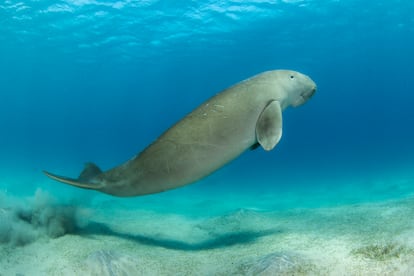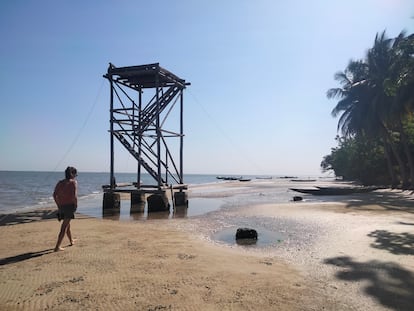The struggle to save the last mermaids of Africa
Deteriorating habitats and illegal fishing are threatening the West African manatee, a species shrouded in mystery fueled by legends


“We, the Diola, cannot catch them. It is forbidden. To catch one you must have mystical powers,” says Louis Diatta, sitting on the banks of the Casamance River, scanning the surface of the water and talking about the West African manatees as if they were people. “They are like us,” he says. “The females have breasts and suckle their babies. They move as a family. Instead of arms and legs, they have fins, but when you look into their eyes, you get a surprise. It’s as if they were half human.”
The Pointe de Saint George is one of the few places in Senegal where you can observe West African manatees, an endangered species shrouded in mystery. If you’re lucky, that is, because, like all legendary beings, they are shy and elusive.
Although the capture, sale and consumption of the West African manatee has been officially banned since 2013, the fact is that there is a flourishing black market in manatee meat, skin and oil, to which curative properties are attributed and for which there is high demand in Asia. The illegal fishing, together with pollution, dams, the disappearance of mangrove forests and accidental catches, are making life hard for the manatee, of which there are fewer than an estimated 10,000 left in the coastal waters and estuaries of a dozen countries. The Pointe de Saint George, an observation tower, rises above the beach and allows tourists to try for a precious photo of Trichechus senegalensis. “There is a freshwater spring nearby and the baliali [their name in the Diola language] like to come here to drink,” says Diatta.
The road to this place is as magical as the manatees themselves. A nine-kilometer path that links this village to the rest of the world takes you through huge flamboyant trees and baobabs, rice fields and mangroves. Here and there, you can see animal bones and gourds placed with care. “These are the charms, protecting the road,” notes Kanyar, a local guide. “That’s why it’s a safe place.” If anyone finds any lost objects, they are obliged to leave them here. On one occasion, a tourist accidentally left a valuable camera on a branch. “The following day, it was next to the charm,” Kanyar says with a smile.
It is estimated that there are fewer than 10,000 manatees left in the coastal waters and estuaries of a dozen countries
The respect for the traditions of their ancestors also prevents the locals from catching manatees, although sometimes these creatures get caught in the nets of shrimp fishermen and suffocate. “I’ve seen it more than once,” says Diatta, who has named his beachside camp Le Lamantin – manatee in French. “Whoever this happens to is obliged to notify the authorities, otherwise they could be heavily fined.”
Legend has it that a newlywed couple once went to a pond to bathe and, being alone and away from prying eyes, began to make love. It so happened that the bride’s father also wanted to cool off and stumbled by surprise on the young lovers. The couple was so embarrassed that they decided to stay in the water forever and turned into manatees. This is the story that the Diolas tell their children and that, combined with the taboo of nudity and sex, reinforces the half-human character of the animal.
In the Bijagos archipelago of neighboring Guinea-Bissau, manatees are linked to the legend of Mami Wata, an aquatic divinity often described as a female, half human, half fish, both extraordinary and powerful. According to tradition, Mami Wata abducts lost bathers and travelers and endows them with unique intelligence and wisdom, should she set them free. This goddess, also present in the voodoo of the Caribbean and America via slaves from Benin and Nigeria, is also associated with sexual promiscuity.

Manatees have become a tourist attraction at La Pointe de Saint George and in neighboring Bijagos. However, a lack of government support means locals must develop tourist initiatives themselves. “The observation tower has been broken for some time now and we are looking at repairing it ourselves,” Diatta says. While the manatee’s cousins in Florida and the Amazon have been protected since 1975 and have been the focus of conservation and research, the African manatee has had to wait 38 years to gain similar status, according to the Robin des Bois association. All this, despite the fact that this herbivore, which can measure more than 6ft 5in (two meters) and weigh about 1,100lb (500 kilos), is essential for controlling the growth of invasive herbaceous species in the region’s rivers and lagoons.
Lacking the immediate glamour of lions, giraffes and elephants, African manatees face numerous dangers from human activity. Climate change and the rising temperature of the water in which they live are also adversely affecting them. One of the problems is their low reproductive rate: females give birth to just one baby after a pregnancy that lasts 12 to 14 months. There then follows a two-year nursing period. Already extinct in the Central African Republic and probably in Burkina Faso, Angola, Niger, Mali and Chad, this sea cow, as it is also known, survives in very limited areas of coastal regions, from Senegal to Equatorial Guinea.
Sign up for our weekly newsletter to get more English-language news coverage from EL PAÍS USA Edition
Tu suscripción se está usando en otro dispositivo
¿Quieres añadir otro usuario a tu suscripción?
Si continúas leyendo en este dispositivo, no se podrá leer en el otro.
FlechaTu suscripción se está usando en otro dispositivo y solo puedes acceder a EL PAÍS desde un dispositivo a la vez.
Si quieres compartir tu cuenta, cambia tu suscripción a la modalidad Premium, así podrás añadir otro usuario. Cada uno accederá con su propia cuenta de email, lo que os permitirá personalizar vuestra experiencia en EL PAÍS.
¿Tienes una suscripción de empresa? Accede aquí para contratar más cuentas.
En el caso de no saber quién está usando tu cuenta, te recomendamos cambiar tu contraseña aquí.
Si decides continuar compartiendo tu cuenta, este mensaje se mostrará en tu dispositivo y en el de la otra persona que está usando tu cuenta de forma indefinida, afectando a tu experiencia de lectura. Puedes consultar aquí los términos y condiciones de la suscripción digital.
More information
Archived In
Últimas noticias
Most viewed
- Sinaloa Cartel war is taking its toll on Los Chapitos
- Oona Chaplin: ‘I told James Cameron that I was living in a treehouse and starting a permaculture project with a friend’
- Reinhard Genzel, Nobel laureate in physics: ‘One-minute videos will never give you the truth’
- Why the price of coffee has skyrocketed: from Brazilian plantations to specialty coffee houses
- Silver prices are going crazy: This is what’s fueling the rally










































